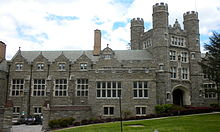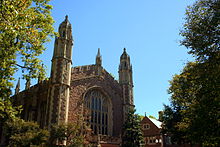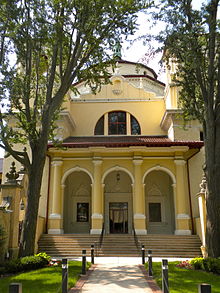- Cope & Stewardson
-
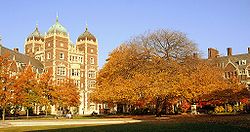 University of Pennsylvania Quadrangle Dormitories, Philadelphia, Pennsylvania (1895).
University of Pennsylvania Quadrangle Dormitories, Philadelphia, Pennsylvania (1895).
Cope & Stewardson (1885–1912) was an architecture firm best known for its academic building and campus designs.[1] The firm is often regarded as a Master of the Collegiate Gothic style. Walter Cope and John Stewardson established the firm in 1885, and were later joined by Emlyn Stewardson in 1887. The firm went on to became one of the most influential and prolific Philadelphia firms to span from the nineteenth to the twentieth centuries. Between 1886 and 1904, they made formative additions to the campuses of Bryn Mawr College, Princeton University, the University of Pennsylvania, and Washington University in St. Louis. [2] In 1912, the firm was succeeded by Stewardson & Page formed by Emlyn Stewardson and George Page.[3]
Contents
Style and influence
Although Walter Cope and John Stewardson were major exponents and purveyors of the Collegiate Gothic architectural style which swept campuses across the country in the latter part of the nineteenth century and early twentieth centuries, they were equally adept at other styles and other building types. Their earliest important commission was Radnor Hall at Bryn Mawr College (1886), where, ironically, they replaced Cope's mentor Addison Hutton as campus architects. Commissions shortly followed for buildings on the campuses of the University of Pennsylvania, Princeton University, and Washington University in St. Louis (serving as administrative buildings for the 1904 St. Louis World's Fair). [4] Although these academic buildings were their hallmark, other projects included residential, commercial, institution, and industrial buildings.
As important as their contribution to the architecture of Philadelphia and its environs is the role which Cope & Stewardson played in architectural education. Great numbers of young apprentices and would-be architects passed their days of training in the office, making it a general stopping place for many architects who would later become famous in their own right. In 1923 the annual T-Square club exhibition catalog published a photograph of the Cope & Stewardson office from about 1899. Included in the number of partners and younger architects are: Walter Cope; John A. MacMahon; James O. Betelle (later of Newark, NJ); Emlyn Stewardson; S. A. Cloud; Wetherill P. Trout; Herbert C. Wise; James P. Jamieson; Eugene S. Powers; E. Perot Bissell; Louise Stavely; Charles H. Bauer (later in Newark, NJ); William Woodburn Potter; John Molitor, Camillo Porecca; and C. Wharton Churchman.
Walter Cope (1860–1902)
In 1860, Walter Cope was born in Philadelphia to Thomas P. Cope and Elizabeth Waln Stokes Cope. After graduating from the Germantown Friends School, he attended classes at the Pennsylvania Academy of the Fine Arts in 1883. In 1885 the firm of Cope & Stewardson was established.
Cope was a founding member of the T-Square Club in 1883 and later served as vice-president, secretary, treasurer, president, and as a member of the executive committee. He was also a Professor of Architecture at the University of Pennsylvania from 1892 to 1902. After teaching at Penn, he became a Professor at the Pennsylvania Academy of the Fine Arts. He died after suffering a stroke in 1902.
Cope was also part of the investigating committee appointed to study conditions governing the new State Capitol Building competition in 1901. From 1896 to 1898 he was chairman of the committee on the restoration of Independence Hall.
John Stewardson (1858–1896)
John Stewardson, son of Thomas and Margaret Haines Stewardson, was born in 1858. His early education had been in private Christian schools in the Philadelphia area. He continued his studies at Adams Academy in Quincy, Massachusetts from 1873 to 1877. After graduation, he entered Harvard College, but left in 1878. He briefly continued his studies at the University of Pennsylvania and then joined the Atelier Pascal in Paris, France. In 1882 he returned to Philadelphia, working first in T. P. Chandler's office and then in the office of Frank Furness.
In 1884 he returned to Europe to travel through Italy and Belgium. A year later, he joined in personal practice with Walter Cope. They were joined in 1887 by John's younger brother Emlyn L. Stewardson, who had recently graduated from the University of Pennsylvania with a degree in civil engineering.
In 1892, Stewardson joined the University of Pennsylvania as staff lecturer in their new School of Architecture. He was also one of the founding members of the T-Square Club, serving in 1885 and 1891 as president of that organization. He also served as treasurer of the Philadelphia Chapter of the American Institute of Architects (AIA) in 1886.
He is credited with the taste for English Gothic Revival which Cope & Stewardson used in their collegiate buildings. Talbot Hamlin, in his biographical description, for the Dictionary of American Biography notes that, following Stewardson's trip to England in 1894, the buildings at the University of Pennsylvania, which were on the boards at the time, changed from stone structures to brick with stone trim.
Stewardson died in 1896 after a skating accident on the Schuylkill River, where he had gone for an afternoon's outing with his friend, the architect Wilson Eyre. Following his funeral his fellow architects established a fund, now known as the prestigious Stewardson Fellowship, which is awarded annually to promising young architects from the Commonwealth of Pennsylvania to study architecture abroad.
Selected Buildings
Rockefeller Hall, Bryn Mawr College
Bryn Mawr College
- Radnor Hall, Bryn Mawr College (1890)
- Denbigh Hall, Bryn Mawr College (1891)
- Dalton Hall, Bryn Mawr College (1893)
- Pembroke Hall, Bryn Mawr College (1894)
- Rockefeller Hall, Bryn Mawr College (1904)
- M. Carey Thomas Library, Bryn Mawr College (1906)
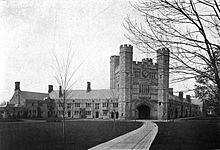 Blair Hall, Princeton University
Blair Hall, Princeton University
Princeton University
- Blair Hall, Princeton University (1896)[1]
- The Ivy Club, Princeton University (1897)
- Stafford Little Hall, Princeton University (1898)[2]
- University Gymnasium, Princeton University (1902)
University of Pennsylvania
Graham Chapel, Washington University in St. Louis, Missouri
- Quadrangle Dormitories, University of Pennsylvania (1895)[3]
- Law School, University of Pennsylvania (1898-01)
- Towne Building, University of Pennsylvania (1903–05)[4]
- Veterinary School, University of Pennsylvania (1906–11)
- St. Anthony Hall Fraternity, University of Pennsylvania (c. 1908)
- Bennett Hall, University of Pennsylvania (1910)
- Leidy Labs (Zoology), University of Pennsylvania (1911)[5]
Washington University in St. Louis
- Busch Hall, Washington University, St. Louis (1900)
- Cupples Hall I, Washington University, St. Louis (1901)
- Cupples Hall II, Washington University, St. Louis (1901)
- Prince Hall, Washington University, St. Louis (1901, demolished 2006)
- Ridgley Hall and Holmes Lounge, Washington University, St. Louis (1902)
- Umrath Hall, Washington University, St. Louis (1902)
- Eads Hall, Washington University, St. Louis (1902)
- Francis Gymnasium, Washington University, St. Louis (1902)
- Brookings Hall, Washington University, St. Louis (1902)
- McMillan Hall, Washington University, St. Louis (1907)
- Graham Chapel, Washington University, St. Louis (1909)
Buildings Elsewhere
- Gray Gables, Darlington, Maryland (c. 1885)
- Anoatok (Kane Manor Inn), Kane, Pennsylvania (1896)
- Overbrook School for the Blind (1899)
- College of Physicians of Philadelphia (1909)
Gallery
-
Quadrangle Dormitories, University of Pennsylvania, Philadelphia, Pennsylvania (1895)
-
Lower Quad in Winter, University of Pennsylvania, Philadelphia, Pennsylvania (1895)
-
Anoatok (now Kane Manor Inn), Kane, Pennsylvania (1896)
-
University of Pennsylvania Law School (now Silverman Hall), Philadelphia, Pennsylvania (1898–1901)
-
Brookings Hall, Washington University in St. Louis, Missouri (1902)
-
Ridgley Hall, Washington University in St. Louis, Missouri (1902)
-
Holmes Lounge, Washington University in St. Louis, Missouri (1902)
-
McMillan Hall, Washington University in St. Louis, Missouri (1907)
-
Graham Chapel, Washington University in St. Louis, Missouri (1909)
-
Blair Arch, Princeton University (1896)
-
Buyer Hall, Princeton University (1896)
-
Little Hall, Princeton University (1898)
References
External links
Categories: Architecture firms based in Pennsylvania | University of Pennsylvania | Washington University in St. Louis | Companies based in Philadelphia, Pennsylvania | Companies established in 1885
Wikimedia Foundation. 2010.


